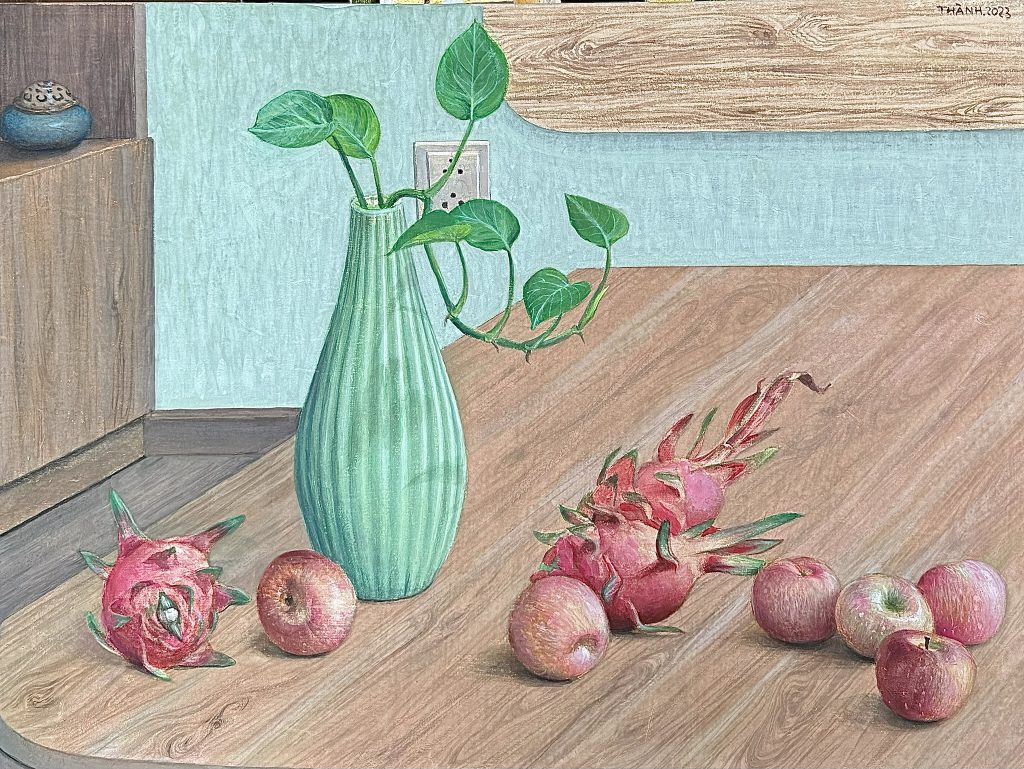Story: Anh Dao
As a pioneer of Vietnam’s contemporary arts in the 1990s and one of the first Hanoian painters to partake in an international exhibition, the painter Nguyen Minh Thanh left a strong mark through his artistic experiments, including performance and installation art works. However, he then seemed to disappear from the art scene, with no exhibitions and little interaction.

Ever since your release of the impressive painting “Cái mặt tôi” (My Face) on Do paper in 1998, your face has been nowhere to be seen. Where have you been?
Public attention does not sit well with me. After that period, I lived in Dalat for five years and painted quietly. Life is more beautiful if we only have to think about what’s necessary. Now, I paint whatever I like, with no theme, concept, or intended ideology. I paint as if I were learning to paint. In the past, I would feel happy whenever beauty appeared. Now, I have realized that when I am happy, beauty appears.
Does it mean that “your face” will no longer show up in paintings?
I did not mean to paint myself originally. I wanted to paint “a human face” with happiness and sadness, with the good, the ugly, and the bad. I touched up the face, I accentuated the lips, and I made the face rounder and rounder. In the end, when I looked at “him”, he looked at me. His nose looked like mine. He was not talking and perhaps I was not talking myself. That was when I could no longer deny that I had actually been painting myself.
My face has not disappeared from my paintings. When the time is right, it will be seen again. It’s just that I am still on the hunt for beauty around me, in the teachings of Buddha, and in meditation.
Does this mean that your recent works are inspired by the teachings of Buddha and meditation?
When you meditate, the first thing you learn about is yourself. External influences will then no longer matter to you. When you understand the nature of life, your current life will feel like heaven on earth. As Buddha said, do not expect your life to be heaven on earth, life is what you make it.
Or as Osho (1931-1990), a renowned Indian philosopher and holy man, wrote in his book “Emotions”: “Change is the only immutable law of the universe. Everything changes, even change itself. Accept change as part of life. Don’t try to fight it because you will only make things worse.”
I no longer paint for others, for my career, or for fame. I only do two things. First, I paint what I like, to which there is no limit, plus what I like changes all the time. Second, I paint to earn a living. The moment I decided to paint what I liked, I realized that it’s not easy to paint what you like well (laughter).
Well, you’ve just discovered a surprising truth. Thank you for sharing your story.
The painter Nguyen Minh Thanh was born in 1971 in Hanoi.
He graduated from the Vietnam University of Fine Arts (previously known as the Hanoi College of Fine Arts). Between 1990 and 2000, he experimented with less conventional forms of art, including performance and installation art works, and played a crucial role in laying the foundation for Hanoi’s contemporary and experimental arts scene.
Nguyen Minh Thanh is interested in concepts of Buddhism including attachment and detachment. He primarily employs Chinese ink and watercolors on Vietnam’s traditional Do paper. This painter has explored themes like familial relationships through the lens of society, philosophy, and psychology, with portraits of himself and his mother.
His works are on display in Vietnam and overseas. They may be found in many public and private collections, including those of the Queensland Art Gallery (Brisbane, Australia), Fukuoka Asian Art Museum (Japan), World Bank Art Program, and Vietnamese Contemporary Art Collection (Switzerland). They are also in private collections of celebrities like Veronika Radulovic (Germany).










